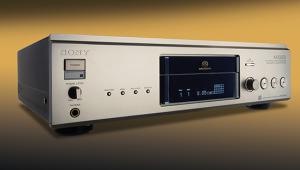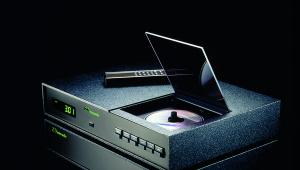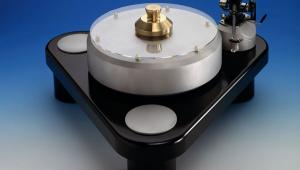Cadence Arca Page 2
Against The Grain
While the bass and lower midrange was exceptional, being quick, low in distortion, articulate and highly defined, the upper mid was congested, closed in and lacking in projection as well as transparency. Focus was quite good, but no match for the near-holographic presentation of the Audio Physic Caldera or the Wilson WITT loudspeakers. The image is not particularly wide and the impression of depth varies with the energy distribution of the programme.
While I never felt that treble made a large enough contribution to the whole, it was nonetheless exceptional. Grainless, resonance-free and almost ethereal in its delicacy, it had that remarkable ability to make a number of substantially good and deservedly popular dome tweeters sound faintly mechanical in comparison.
The treble sounded airy and spacious, easy on the ears, if lacking in attack in the lower part of its range. Whether it was the responsibility of the electrostatic tweeter, or of the system integration, rim shots, wood block and similar leading-edge transients were significantly muted.
However, when it came to cathedral organ, the Arca could really take your breath away in the bass. Full-blooded, the bass tunes just poured on, extending right down to 30Hz in my room.
Lab Report
From the reference curve, the base line sensitivity was agreed at 90dB/1W, though in the listening room the relatively muted treble would suggest a lower subjective figure than this. With a 150W power capacity, in-room sound levels of 107dBA will be possible and this speaker is certainly capable of driving larger rooms. A minimum power of 25W is suggested.
That said, the axial frequency response is unpromising for a speaker at this elevated price level and, in particular, there is a moderately damped peak of 2-3dB at 600Hz, which may well be associated with the subjective finding of significant coloration in the midrange. I reckon it's made worse by the fall in output at frequencies beyond this – there's a general trough of 4dB between 1.5kHz and 6kHz. This appears to correlate with the subjective finding of a loss of presence and attack on percussion sounds.

The curve [Fig 1] shows a fast rolloff from the bass unit at the nominal crossover point of 1.2kHz. The electrostatic is falling in output by this frequency but continues more weakly right down to 700Hz with a slow rolloff. Bass, however, is well extended to 30Hz.
The –6dB and power tests showed low distortion even at 30Hz (re. 25W continuous) which is a very good result. The bass is almost maximally flat confirming the need for near free-space placement.
As for the off-axis responses, those in the vertical plane are separated from the lateral results. Below axis [Fig 2] the correspondence is good up to 5kHz, above which frequency the output falls rapidly to –20dB by 15kHz. The moral is, don't sit too low or the output will be seriously dull. Above the median axis the treble holds out to 12kHz, with only about 2dB variation, which has to be judged a good result over the main band.
Keeping Time
In the horizontal plane [Fig 3] I have plotted the output for on-axis, 15o, 30° and 45° off-axis. Only the last figure showed serious loss in level, so the curvilinear electrostatic driver is doing quite well to control directivity in the frontal arc. What is consistent throughout is the underlying unevenness in the Arca's amplitude/frequency response.
The ETC (energy averaged response) showed that fairly good time alignment has been achieved for the two drivers, and the transient performance of the electrostatic is very fine, just a millisecond for 45dB of B-H weighted decay. Some evidence of the mid peak is seen as a spectrally shifted ridge in the waterfall decay presentation [Fig 5] but the upper range is very good, showing that the mild treble irregularities are geometric rather than due to stored energy phenomena.
It's hard to quantify the impedance curve [Fig 4] which, like many electrostatic speaker loads, descended to a very low value at the highest frequencies. In this case it measured 2ohm for 20kHz, and 4ohm at 10kHz, averaging 5ohm overall. This is a fairly tough load and the largely capacitative nature at high frequencies may affect some amplifiers and interact with higher inductance speaker cables, but a good dealer will be able to advise on amplifier combinations.

Finally turning to the room averaged response, there was evidence of some room-interface lift, but not to the extent of a 'boom'. It's relatively smooth, +4dB up to 1.5kHz, a little 'peaked' at that 500-600Hz 'trouble spot', and then it suffered a significant drop of some 5dB in energy into the treble band. This was clearly audible in the room reverberance, which is on the sweet side. The output then continues with a minor peak at 10kHz, to a satisfactory –10dB at 20kHz.
Conclusion
I'm aware that considerable effort and expense has gone into this ambitious project and this includes the design of the predecessors to the Arca. I also know that given a big space and a careful choice of material it is possible to get interesting and musical results. However, for me, that's not enough. I found that the admirable bass and the delicate treble didn't meet well enough in the middle to achieve a consistently convincing sound.
There's a coloration flaw audible in the upper range of the bass driver, while the treble unit didn't provide sufficient energy in its lowest octave.
Undeniably there's much good engineering and fine construction invested in this loudspeaker system, but unfortunately I didn't favour the overall performance. Perhaps the judicious addition of a well selected mid driver would help.
One thing is clear, there is much expertise to be found in this design, and we can expect to hear more from Cadence in the future.


















































